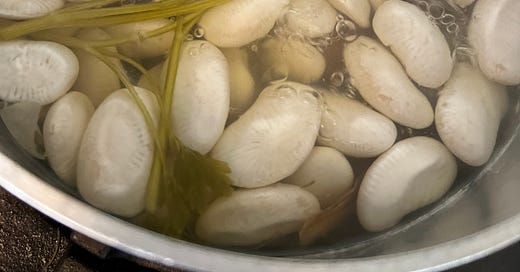Issue #120: Beans on the Menu
A Global Program Comes to NYC, Cooking Beans, A Greek Stew of Gigantes, Spinach, and Feta
This week on What’s Burning I interview Barb Stuckey, Chief Innovation and Marketing Officer of Mattson, a company that has for decades been at the forefront of new product development for the food industry. It’s a fascinating conversation about food innovation, taste empathy, stomach share, sustainability, and the next big trend, which, according to Mattson, is precision fermentation. You won’t want to miss this window into the future. Listen wherever you get your podcasts or click below.
When people ask me what’s my favorite bean, I usually say gigantes.
Before you get all worked up thinking that nobody ever asks such a thing, consider that I was just interviewed for a podcast and the first question was exactly that. It happens more than you might think.
As you may have seen in my editor’s note in last week’s issue, I’ve been helping to coordinate the local activation of a global campaign to double the consumption of beans and other legumes by 2028. Called Beans is How, this campaign is the brainchild of former Obama food policy advisor and chef Sam Kass. It’s being spearheaded by food-system change advocate Paul Newnham of the Sustainable Development Goal 2 Advocacy Hub, home of the global network of sustainability minded chefs called the Chefs’ Manifesto.
Why beans? At the most basic level, Sam’s suggestion was to focus on just one thing to see if a concentrated global effort could move the needle in a positive direction. Tackling climate change is huge. Changing the food system, which is one of the largest contributors to greenhouse gas emissions, is overwhelming. Where do you start?
Beans Count
They picked beans as their focus because beans are good for so many reasons. Beans are nutritious, a good source of protein, fiber, and other beneficial nutrients. Beans are easy to grow in a regenerative way, as they can produce multiple crops in a season and they help fix nitrogen in the soil, which reduces reliance on fertilizer. Beans are affordable and plentiful. There’s also a huge variety of beans that are integral to most food cultures around the world. (Click here for a comprehensive Theory of Change behind the program.) What’s more, beans are delicious.
About that last point. I know first hand that there are people who find beans gross. My husband Nate is one of them. Although he’ll tell you it’s their texture and flavor that turns him off, I think he also has a mental image of beans being icky. Like many bean haters, he likes hummus, refried beans, tofu, bean threads, and other forms of beans that are less beany, if you will. You see, beans are versatile, too.

Back to gigantes. What’s the big deal with this big bean? First off, I get a kick out of their size. Aptly named, gigantes are nearly three or four times the size of most other beans. How cool is that? I love the classic way gigantes are most often prepared in Greece, stewed in tomato with dill and lemon. But I like them any way, in stews, in soups, in pastas. Lately, based on an idea I saw in a Yotam Ottolenghi recipe, I even like them fried. They are creamy and flavorful and, did I mention they are huge? The Spanish equivalent, alubias Garrafon, which are integral to a classic paella Valenciana (see Issue #108), are equally delicious.
Why Not Beans?
One of the reasons folks don’t eat more beans at home, I’ve learned, is they believe they are complicated to cook. They aren’t. Of course, you can use canned beans in a pinch. But canned beans don’t afford the same flavor, texture, and variety as dried beans. Would that we lived in Barcelona, where you can find beautiful shops that sell beans in every stage, dried, soaked, and cooked, ready to incorporate into any recipe. The variety of beans, pulses and legumes in Indian markets is astounding, both for the different types they sell, but also the different states in which they are available, such as whole, peeled, halved, sprouted, flours, and more. Almost no meal in Latin America is complete without some form of beans and rice. Beans, beans, beans.

What Can You Do?
Eat more beans! If you live in the New York City area, go out to the restaurants, fast-food places, and street vendors participating in the Beans is How Menu Challenge NYC from now until October 31. Order the bean dishes on the menu. Photograph them, post about them, share the bean love. (Please tag @beansishow @chefsmanifesto and #beansonthemenu.) You can find a complete list of participating restaurants here.
And if you are a restaurant in the NYC area who wants to join in the bean fun, you can sign up here.
If you live elsewhere, ask your favorite restaurants to put beans on the menu and have them sign up to participate in the global campaign here.
And if you are cooking at home, make more beans! Keep reading.
TECHNIQUE: Cooking Dried Beans
I almost always have a container of cooked beans in my fridge. I make them at the start of the week and throw them into salads, soups, pastas and other noodle dishes when Nate isn’t looking. (I also season the bean cooking water to make soups for lunch or to use as broth for ramen or other noodles.) Although, I’m always cooking a different bean I picked up from somewhere or another, I cook them all basically the same way.
Soak about a ½ pound (1 cup or so) of beans overnight or early in the morning in abundant water with about a tablespoon of salt. Twelve hours later, drain and rinse them and put them in a pot covered with about 2 or 3 inches of fresh water. Add a smashed clove of garlic, a piece of onion or other allium, a knob of carrot, some celery tops, a few whole sprigs of parsley, a bay leaf, and a teaspoon of salt.

Yes, I know there’s a belief that salting the water for soaking and cooking beans toughens them. But several folks with more than time than I have to explore such things, including seriouseats.com, have tested this theory ad nauseam and it just isn’t the case. What’s more, beans cooked with salt have more flavor and and a better texture. But do as you wish.
Bring the pot to a boil, reduce the heat to a simmer, set the cover ajar, and cook them until they are just done, a touch al dente, usually 45 minutes or so, depending on how old the beans are. They can take up to an hour and a half or more. Add more water if necessary so the beans are submerged. (Note, if I’m going to use the beans in a purée, such as for hummus or refried beans, I cook them longer, until totally soft.) It’s best to let the beans cool in their cooking water, which I find helps them stay plump. Then I remove and discard all the aromatics and transfer the beans and their cooking water to a container to store in the fridge. They will keep about a week before they start to turn slightly sour, after which they are still fine to eat but you might want to incorporate them into a soup or something.

I know that there are proponents who suggest you don’t even need to soak beans before you cook them. That it only saves a nominal amount of boiling time and dilutes the flavor. But I’m happy with my technique. If I need them in a pinch and forgot to soak them the night before, I use a pressure cooker, putting in the same ingredients, bringing it all to high pressure, and then letting them cook for 12 to 13 minutes for al dente and 15 minutes for soft, again depending on the beans and their age.
Note that soaking is not necessary for certain small beans or legumes, such as lentils, split peas, or black-eyed peas. Neither is soaking required for freshly shelled beans, which are increasingly available in farmers markets.
See, beans are not difficult at all.

Now that they are cooked, what should you do with them? Well, this weekend I was visiting my friend Peggy in Portland, Maine. Peggy is an editor and a reporter a the Portland Press Herald and she has a vast collection of cookbooks I pored over while I was there. One classic, The Glorious Foods of Greece by an old friend Diane Kochilas (William Morrow, 2001), had a recipe for gigantes I couldn’t wait to get home to make (mostly because of my love of these oversized beans and because I knew I had all the ingredients in my fridge). Diane noted the dish was traditional and common around the Epirus region of Greece. Peggy noted in a scribble on the page that the result was delicious but a lot of work. I could see what she meant, and when I came home to cook them, I adapted the recipe to make it a little less labor intensive (with apologies to any Eperian cooks). I’ve been eating them for days, happily knowing not only that they are delicious, but that they are good for me and for the planet.
RECIPE: Gigantes Beans Baked with Spinach and Feta
(serves 8)
3/4 cup extra-virgin olive oil
1 very large Spanish onion or 2 large white onions, chopped (about 2 cups)
Sea salt and freshly ground black pepper
2 cups cooked, drained, and chopped spinach (from about 2 pounds fresh) or the equivalent of frozen, defrosted
1/2 cup chopped fresh dill
1/2 cup chopped fresh parsley
8 ounces goat or sheep’s milk feta, crumbled (about 1 1/2 cups)
2 large beefsteak tomatoes, pulp grated off the skin, see Issue #116 (about 2 cups), or the equivalent of canned crushed tomatoes
2 1/2 cups cooked Greek gigantes beans or other large, white butter beans, such as Spanish alubias Garrafon, from about 1 cup (1/2 pound) dry beans (see technique above)
2 cups reserved bean cooking water
1/3 cup unseasoned bread crumbs
Preheat the oven to 350°F. In a wide, shallow, covered Dutch oven or casserole that can go from the stove to the oven, heat a couple of tablespoons of the olive oil over medium-high heat. Add the chopped onion and a pinch of salt, and cook until soft, about 7 minutes. Season with some black pepper. Add the cooked spinach, dill, parsley, ½ cup of the olive oil, about 2/3 (1 cup) of the crumbled feta, 1 cup of the tomato pulp, the beans and the bean cooking liquid and mix well. Season with salt and pepper. Spoon the remaining cup of tomato pulp over the top. Dot with the remaining 1/2 cup of crumbled feta and sprinkle the bread crumbs over everything. Drizzle with the remaining 2 tablespoons of olive oil, cover, and bake for about 1 hour until rich and bubbly. Remove the cover and bake another 20 minutes or so to brown the top a little. The beans should be soft and silken. Serve hot or lukewarm in bowls with additional chopped herbs for garnish and plenty of fresh bread to soak up the flavorful broth.







I shall rise to your challenge, Mitchell, and post a paean to beans (a baean?) next week. What a happy idea, thanks for the inspiration.